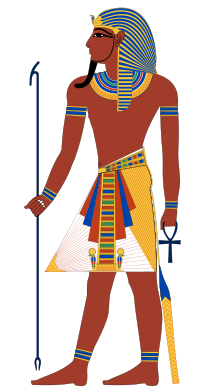The title "Pharaoh" is used for those rulers of Ancient Egypt who ruled after the unification of Upper and Lower Egypt by Narmer during the Early Dynastic Period, approximately 3100 BC. However, the specific title "Pharaoh" was not used to address the kings of Egypt by their contemporaries until the rule of Merneptah in the 19th Dynasty, c. 1200 BC. Along with the title Pharaoh for later rulers, there was an Ancient Egyptian royal titulary used by Egyptian kings which remained relatively constant during the course of Ancient Egyptian history, initially featuring a Horus name, a Sedge and Bee (nswt-bjtj) name and a Two Ladies (nbtj) name, with the additional Golden Horus, nomen and prenomen titles being added successively during later dynasties.
Egypt was continually governed, at least in part, by native pharaohs for approximately 2500 years, until it was conquered by the Kingdom of Kush in the late 8th century BC, whose rulers adopted the traditional pharaonic titulature for themselves. Following the Kushite conquest, Egypt experienced another period of independent native rule before being conquered by the Achaemenid Empire, whose rulers also adopted the title of "Pharaoh". The last native pharaoh of Egypt was Nectanebo II, who was pharaoh before the Achaemenids conquered Egypt for a second time.
Achaemenid rule over Egypt came to an end through the conquests of Alexander the Great in 332 BC, after which it was ruled by the Hellenic Pharaohs of the Ptolemaic Dynasty. Their rule, and the independence of Egypt, came to an end when Egypt became a province of Rome in 30 BC. Augustus and subsequent Roman emperors were styled as Pharaoh when in Egypt until the reign of Maximinus Daia in 314 AD.
The dates given in this list of pharaohs are approximate. They are based primarily on the conventional chronology of Ancient Egypt, mostly based on the Digital Egypt for Universities[3] database developed by the Petrie Museum of Egyptian Archaeology, but alternative dates taken from other authorities may be indicated separately.


Comments
Post a Comment